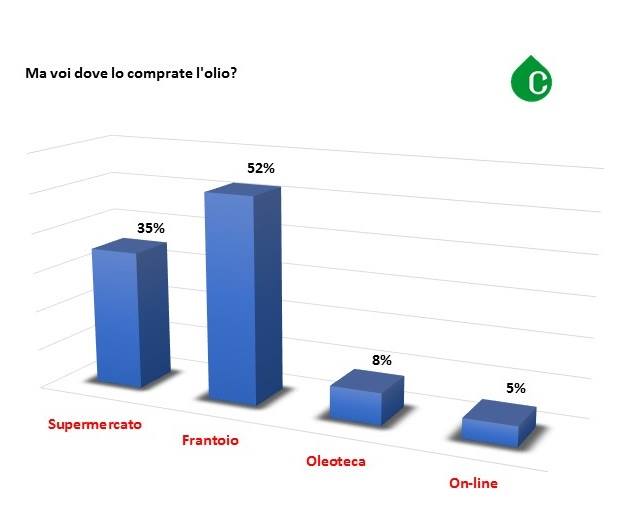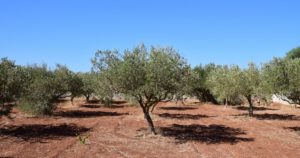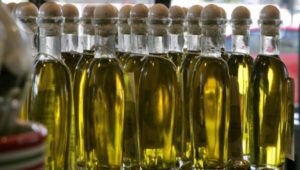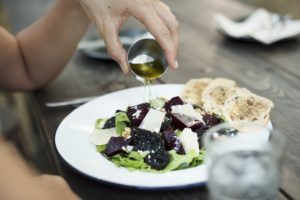Where do you buy oil?
it is a news by Gastroliart – gastroliart.blogspot.it
We all, everyone among us, we are convinced that the oil we buy is an excellent oil. It does not matter if you buy it in an oil mill, in a supermarket, in a olive oil shop or on specialized websites, we are all convinced that “mine is better than yours”.
Starting from this very Italian “truth”, we created a small poll on Twitter and then relaunched on Fb that gave four possible answers.

This picture reflects, more or less, the Italian situation, where most of the people buy in the mill (meaning with the mill in general buying direct from producers) and then to follow supermarket, oil and online.
What emerges from the research “The green Italian gold” of AICIG, ISMEA and ZOWART, reported with reference to the survey by Susanna Benedetti (Sommelier of the oil), apart from the well-known fact of the constant growth of consumption of olive oil on an international level, an interesting thing to know is the diffusion of olive oil even outside the borders of traditionally consumer countries, that is due to many factors, including the increasing “contamination” of the culinary traditions that see among the most renowned Mediterranean, and Italian in particular. The problem is that this increase in consumption does not correspond with the awareness and knowledge that one has of the product.
This lack of knowledge would seem to be reflected in the purchasing methods that emerged from the answers to the question “where do you buy the oil”. If the direct purchase from the producer (frantoio) is the prevailing answer, it should be noted that comments would seem to emerge that this choice is driven not so much by the awareness of the quality of the oil purchased and the skills of the producer but the hope that it is a genuine oil. The oil purchased from the mill, usually is produced by local olives, has a higher cost than that on the shelves of supermarkets and Gdo, a method of purchase that follows in the polls the mill. The latter, however, is in most cases a blend of EU and non-EU oils, sold at very low prices and which, as demonstrated in recent years by numerous investigations, often does not even have the organoleptic characteristics to be defined as extra virgin olive oil. Marginals, on the other hand, are purchases in local stores and online shop, less traditional places of purchase that have not yet taken place among consumers’ habits but which could have the advantage of a guided purchase, that is supported by selectors with competence related to the product they sell, and overcome territorial boundaries by opening up to a wider range of oils to choose from, obviously, compared to a higher price than that of retail chains.

How do you convince people that an oil bought in oil shop / online shop above 12 euros (average price per liter of this year) is not pure madness but only the approach to a product of high quality that in addition to having a disproportionate wealth of aromas and flavors, also has many health properties that should not be underestimated?
Aims
The online survey was an opportunity for an interesting discussion among various actors in the sector (entrepreneurs, producers, tasters and sommeliers). Leaving aside the preference of individuals between the best choice for purchase, who online, who in the mill and who in the bar (it is no coincidence that no one has mentioned the supermarket?) All of us agree that there is need to spread the culture of oil and therefore the whole is reduced by simplifying a cultural problem and the growing mistrust that is had in the purchase of products that do not know each other and for this we rely on someone else (the producer / miller friend in our case) .
Solutions for trend inversion?
There is no only one solution, but the continuous commitment of professionals who constantly compare and support producers on the “road” to product quality and migration in the online world:

The culture like wildfire: we have to start from the restaurant and reflect on the fact that food and wine tourism, particularly appreciated by tourists, represents a new way of traveling that is conquering an increasing number of “oil enthusiasts”, looking for new flavors and authentic traditions. At this juncture, the enhancement and promotion of quality catering takes on a new role, becoming the vector of culture and values firmly linked to its territory and its roots. The restaurant, therefore, is increasingly a vehicle for immediate promotion, because it is a repository of the heritage of knowledge and flavors linked to the traditional cuisine of our land. In this context, quality extra virgin olive oil represents an important excellence. We are sure that the consumer is willing to pay 2 cents for a good olive oil, as we are sure that the habitué of high quality catering want to season a good salad with a good extra virgin olive oil that affects the dish for a few cents. There is therefore an ongoing cultural and educational growth, a nourished attention, the desire to become aware, to understand and to know. There is room for oil from quality olives in catering. The process is unfortunately slow, but something is changing. It would be necessary to create a circuit of quality restaurants and gastronomy, linked to extra virgin olive oil to make the restaurant, a real place of taste, through which to convey information to customers and illustrate the aromatic and aromatic qualities of the various types of oil. Here, we should add professionals and experts such as “the oleologist” or the “oil sommelier”, called to carry out a real work of product culture and correct information. We are many, but we are not enough. We have to continously confront each other without talking to each other and expanding the audience knowing that those we have to convince are not the people who know the product but who the oil has wrong centenarian convictions.

Distribution of the oil shops: the simplest thing to say (and not to do) is to encourage the opening of the oil shops or to help those already existing and make them become places of aggregation just like in the last years in wine shops. In Rome we are fortunate to have three well-stocked oil bars in different parts of the city, but are they enough? In the rest of Italy, how many oil shops are there? Still very few. Umbria and Tuscany already have their places dedicated to oil, they are growing. We must recognize and reward the determination of those who, in a market that is still not very aware, bravely faces the challenge of an activity entirely dedicated to extra virgin olive oil and offers its customers not only excellent and selected products but also all their expertise to spread the knowledge and culture of extra virgin olive oil.

Supporting the producers: this is the most important point because without them, the custodians of our lands, we can spread culture but we will not have fully a true development of this excellence. We need to let the general public know where the extra virgin comes from, how much work and passion it takes to create an excellent product, and the tools are: with storytelling, through the internet, events and meetings, we tell the hard and constant commitment of olive growers and making them “cool” is the most challenging and useful activity that we must continue to make the quality of this sector ever higher. The producers work with great commitment to quality and believe that in the good oil there can be a future, they always and continually put themselves at stake and participate in a great change, a breakthrough that is hard to come to fruition. Making quality has a cost, a value that starts from the territory and passes through the history and the knowledge of the peoples, of the families, to then stop in a bottle of rare quality. The producer’s story activates the attention, puts the emotions in circulation, involves, puts ideas into an order. You can not do without it and you will not do without it. We must recognize the right merit and the right profitability to those who work to delight us and satisfy our senses and even in this the network can help; we can also work to promote the increase in online purchases, to allow as many consumers as possible to reach the best producers and buy their products, thus supporting those who hold high the level of Italian extra virgin olive oil.

To truly promote quality oil, the conscious choice of the consumer is needed: a final reflection must be made on those who have the most decisive role in conveying the choice of purchases and therefore the consumption of quality extra virgin olive oil. All that we have written up is poured into things that have an even greater value than the oil itself: they are values that can not be ignored and on which we invite you to reflect. The sacrifice, sometimes due to the beautiful conformation of the territory and the management of the olive groves – often secular and millenarian – and therefore also the risk, the protection of the landscape and the maintenance and custody of the same. Italy feeds on a great historical-cultural and landscape value, envied around the world for its uniqueness, its biodiversity: all this must be recognized and above all must be supported by consumers, even economically, because otherwise our country it has no chance of competing with countries like Spain or emerging countries like California. Paradoxically, these values are recognized more by foreigners than by Italians.

Does it seem normal?
To promote quality oil, the conscious choice of the consumer is needed.
If we can make sure that this choice is oriented towards true quality extra virgin, the whole sector will have a bright future ahead.
Extra-virgin olive oil will be the food of the century!
Let’s make it known to the world, all together …
+ info about Gastroliart
+ news and info “signed” Gastroliart











